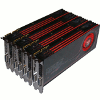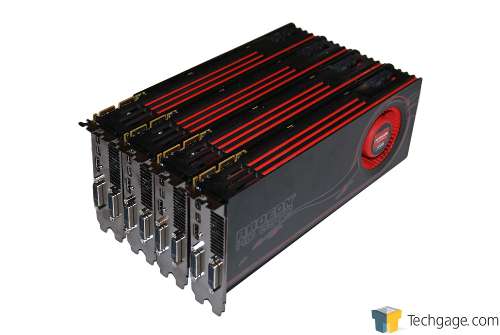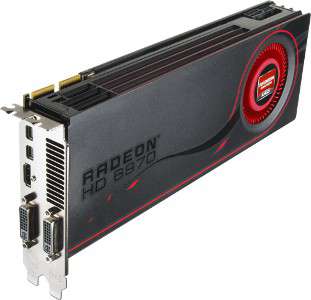- Qualcomm Launches Snapdragon 4 Gen 2 Mobile Platform
- AMD Launches Ryzen PRO 7000 Series Mobile & Desktop Platform
- Intel Launches Sleek Single-Slot Arc Pro A60 Workstation Graphics Card
- NVIDIA Announces Latest Ada Lovelace Additions: GeForce RTX 4060 Ti & RTX 4060
- Maxon Redshift With AMD Radeon GPU Rendering Support Now Available
AMD Radeon HD 6950 & HD 6970 CrossFireX

By most definitions, AMD’s Radeon HD 6900 graphics cards are powerful, but for those who are looking to push huge resolutions, a little more oomph might be desired. That’s where multi-GPU configurations come in, and to see what AMD’s latest are capable of, we’ve tested out both the HD 6950 and HD 6970 in CrossFireX.
Page 1 – Introduction
AMD a couple of weeks ago released its first Radeon HD 6900 graphics card models, and at the time our article was published (about a week late due to various circumstances), we were unable to include CrossFireX performance as we had hoped. So, to help fill in that void, this article will tackle dual-GPU HD 6950 and HD 6970 configurations across our regular suite.
As we’ve come to expect from AMD, pairing up two GPUs to act together is a simple process. After both cards are installed and power connectors hooked up, all that’s needed is a simple CrossFireX bridge to mate the cards. This process is identical to NVIDIA’s SLI, and software-wise, both AMD and NVIDIA offer similar feature-sets.
One aspect we haven’t tackled in the past, but we plan to in the near-future, is CrossFireX vs. SLI. NVIDIA touts more often than AMD that its dual-GPU solution is superior, and that’s something we’d like to put to an honest test. One thing’s for sure, though, and that’s that dual-GPU tech has improved vastly ever since its introduction.
In the earlier days of multi-GPU, we’d be lucky to see 150% of the performance of just one card, but today, when paired with the right software, we can actually see performance increases of up to 200%. In some rarer cases, we can even see that 200% mark exceeded, which goes to show just how mature these configurations are in today’s landscape.
In the photo above (can you tell that my camera’s external flash is broken?) sits AMD’s Radeon HD 6970 and HD 6950 – two of each. As you can no doubt tell, the cards all look identical, and for the most part, there’s little different between them. The GPU dies are of course varied between the two, but on the larger of the two cards, HD 6970, an 8-pin connector is required along with a 6-pin – rather than require two 6-pins.
There’s not a lot to discuss here that hasn’t been touched upon in our launch article, but for the sake of interest, you can review AMD’s current line-up below. At the current time, AMD doesn’t offer a dual-GPU version of an HD 6000 card, but if all goes according to plan, we should be seeing the HD 6990 in early 2011. How it will compare to today’s CrossFireX solutions is yet to be seen.
|
Model
|
Core MHz
|
Mem MHz
|
Memory
|
Bus Width
|
Processors
|
| Radeon HD 6970 |
880
|
1350
|
2048MB
|
256-bit
|
1536
|
| Radeon HD 6950 |
800
|
1250
|
2048MB
|
256-bit
|
1408
|
| Radeon HD 6870 |
900
|
1050
|
1024MB
|
256-bit
|
1120
|
| Radeon HD 6850 |
775
|
1000
|
1024MB
|
256-bit
|
960
|
| Radeon HD 5970 |
725
|
1000
|
2048MB
|
256-bit
|
1600 x 2
|
| Radeon HD 5870 Eyefinity 6 |
850
|
1200
|
1024MB
|
256-bit
|
1600
|
| Radeon HD 5870 |
850
|
1200
|
1024MB
|
256-bit
|
1600
|
| Radeon HD 5850 |
725
|
1000
|
1024MB
|
256-bit
|
1440
|
| Radeon HD 5830 |
800
|
1000
|
1024MB
|
256-bit
|
1120
|
| Radeon HD 5770 |
850
|
1200
|
1024MB
|
128-bit
|
800
|
| Radeon HD 5750 |
700
|
1150
|
512MB – 1GB
|
128-bit
|
720
|
According to AMD’s official specifications page for the HD 6970, a 550W power supply is required for a single GPU configuration. That assumes that the 8-pin connector can deliver at least 150W, while the 6-pin can deliver 75W. Combined, this safely covers the card’s TDP “typical” rating of 190W.
Unfortunately, the company doesn’t give specific information regarding CrossFireX power supply requirements, but given what we’ve seen in our GPU stress-tests, we’d have to recommend at least an 800W unit, with at least 80% efficiency. For dual HD 6950s, I’d recommend a similar unit, as that configuration draws just about 50W less at full load.
Before continuing, it’s important to note that due to architecture limitations, running six monitors on both GPUs is not possible. For that, you’d need to purchase a DisplayPort hub and connect it to the first card. For three monitors, all can be run off of the top card without issue.
Without further ado, let’s take care of our testing methodology explanations, and then we’ll get right into our test results.
Support our efforts! With ad revenue at an all-time low for written websites, we're relying more than ever on reader support to help us continue putting so much effort into this type of content. You can support us by becoming a Patron, or by using our Amazon shopping affiliate links listed through our articles. Thanks for your support!







